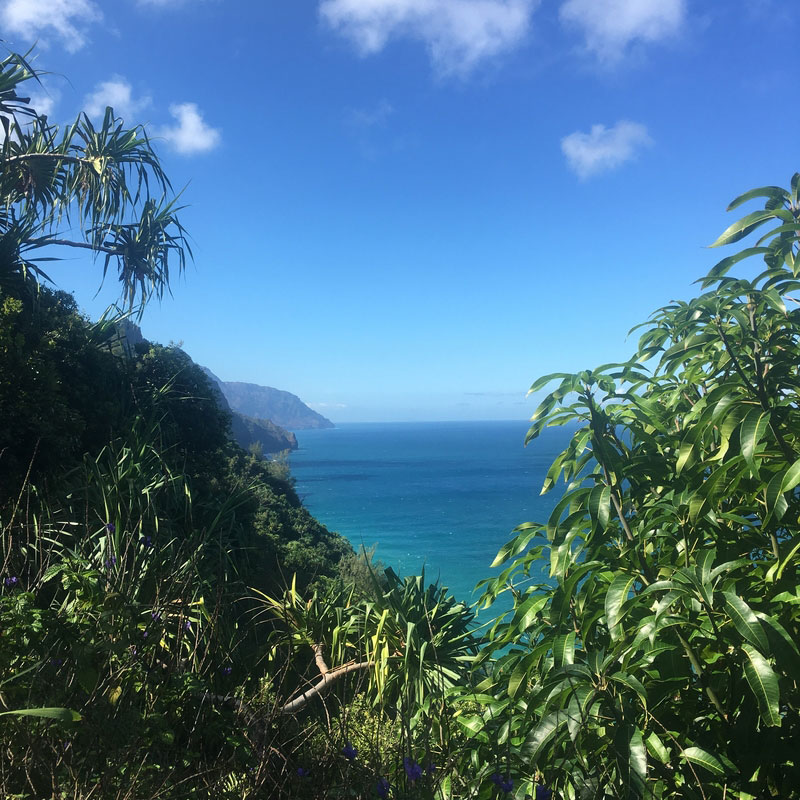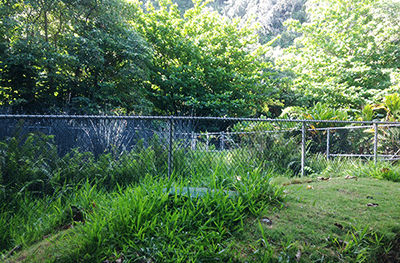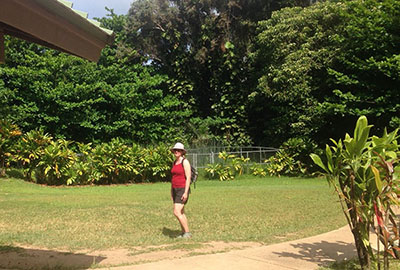Recently I went on a family vacation to Hawaii. One of my aspirations while there was to hike part of the Kalalau Trail, rated by National Geographic as one of the world’s best hikes. I knew we didn’t have enough time to do the whole trail, so planned on hiking the 8-mile round trip to Hanakapi’ai Falls instead. The trail begins at Ha’ena State Park, on the north coast of Kauai, and traverses 11 miles of the Nā Pali Coast. The Nā Pali Coast is very recognizable to many, having starred in lots of Hollywood films, Jurassic Park and South Pacific to name a couple. It is also one of the last wilderness areas in Hawaii, home to many endemic species and native historic places. What does my vacation have to do with my job at Biohabitats?

One of the results of working in a smaller Bioregion is that I get the chance to participate in all aspects of the company–from marketing to technical design. The technical aspect of my job tends to dominate, but I do a fair bit of marketing, including working on proposals for projects that are outside of my technical expertise but relative to my Bioregion. A consequence of this part of my job is that I find out about projects Biohabitats has worked on all over the US. So, going to Hawaii, I knew that we had worked on a project for a state park that started with an H. Ironically, I figured out shortly while there that it was Ha’ena State Park. What did Biohabitats do there?

Biohabitats designed the wastewater wetlands that serve the busy bathroom at Ha’ena State Park. While this doesn’t sound very exciting, it actually is pretty unique. Ha’ena State Park is not only located at the head of the Kalalau trail, it is itself ecologically, culturally, and historically significant, as it was home to a native Hawaiian settlement from 1000 AD to 1800 AD. Hawaiian culture is, and has always been, tied to water; thus, the protection of the site’s natural resources and water quality were of utmost importance. Biohabitats specializes in designing natural wastewater treatment systems, especially for unique or challenging sites that require high levels of ecological and cultural sensitivity.
 At Ha’ena, a busy trailhead comfort station (aka bathroom) with no electricity and limited access down a long rural road, the wastewater system needed to function without power and be easy to construct while still cleaning effluent to safely discharge to groundwater. Working with the State and local Native Hawaiian community, Biohabitats selected a subsurface constructed wetlands planted with Hawaiian species for the project. The system has been in place and functioning well since July 2011.
At Ha’ena, a busy trailhead comfort station (aka bathroom) with no electricity and limited access down a long rural road, the wastewater system needed to function without power and be easy to construct while still cleaning effluent to safely discharge to groundwater. Working with the State and local Native Hawaiian community, Biohabitats selected a subsurface constructed wetlands planted with Hawaiian species for the project. The system has been in place and functioning well since July 2011.

Suzanne, outside the comfort station
I was excited to see a Biohabitats project in such an important place–it is one of the most visited sites on Kauai–and to realize we had a part in protecting the site for future visitors and helping to improve the overall ecology of the area. I have only one regret: the trip will be forever referred to within my family as the one where I had to go see the Biohabitats bathroom.
Further Reading
Meet Assistant Construction Project Team Leader Bryan SullivanMeet Conservation Biologist Nolan Schillerstrom
Get to know Allyson Gibson, Biohabitats Extern
Get to Know Graphic Designer Joey Marshall
Evolution: A New Leadership Team for Biohabitats
More From This Author
An American Ecologist in New Zealand Part V: What is a Cittaslow?An American Ecologist in New Zealand Part VI: Green Infrastructure for SWM
An American Ecologist in New Zealand: Part I
How does Biomimicry Relate to Stream Restoration?
An American Ecologist in New Zealand: Part IV, Green Roofs!

